This article was published in Scientific American’s former blog network and reflects the views of the author, not necessarily those of Scientific American
Regular readers will recall that last year’s birthday – the 10th – was made into a grand, multi-part, debauched epic wherein I looked not only at the year that had passed and at Tet Zoo’s content across the previous year but also at the blog’s wider impact, aims, expansion and future (see the links below for nauseating introspection and omphaloskepsis). Well, I’m not about to do that again; let try and keep this brief (he says). The aim here is to discuss everything of 2016 I consider relevant to the TetZooniverse, to review the year’s taxonomic coverage, to self-flagellate in the prescribed manner, and to then make those vacuous platitudes about the future and about how, one day, it will all work out. So, to business.
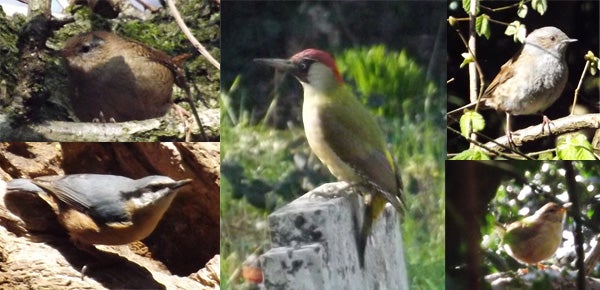
Birds on my local patch, badly photographed during 2016. Have fun and identify them; some are easier than others. Credit: Darren Naish
From a TetZooniverse perspective, 2016 was nuts. Among other things, I published two books and completed one other, spent the summer working as a tour guide, had my house torn to bits and rebuilt, worked as a lecturer, spent days in the field tracking beasts of various sorts, wrote hundreds of pages and did hundreds of illustrations on FISH, acquired guinea-pigs, and spoke at several national and international events. The podcats continued intermittently, some new material appeared at Joan Turmelle and Albertonykus’s TetZoo Time! and Ethan Kocak’s Tet Zoo Comic, err.. remained online. And I wasted hours upon hours photographing – or trying to photograph – small birds. On that last point – and as those who’ve seen my photos on twitter or facebook will know – I failed (see examples above).
On supporting science journalism
If you're enjoying this article, consider supporting our award-winning journalism by subscribing. By purchasing a subscription you are helping to ensure the future of impactful stories about the discoveries and ideas shaping our world today.
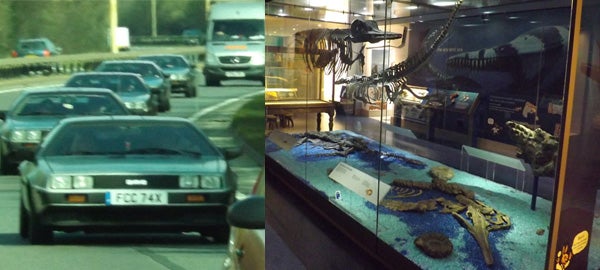
Scenes from a trip to the English Midlands in March 2016. At right: Jurassic marine reptiles at the Peterborough Museum and Art Gallery with that excellent Bob Nicholls piece in the background. At left: a fleet of DeLoreans. Credit: Darren Naish
Hunting Monsters appears. Fresh from all the crazy Tet Zoo 10th birthday celebrations, February kicked off with my cryptozoology book Hunting Monsters brand-new and off the… press (err, it was only out as an ebook at this stage but can right now be pre-ordered as a hardcopy version) (Naish 2016a). I joined Blake Smith and Karen Stollznow for a MonsterTalk interview, which you can listen to here. Hunting Monsters was also covered at Tet Zoo, and my claim (which actually originates from Loch Ness researcher Dick Raynor) that Hugh Gray’s photo of 1933 might show a swan was picked up by the media and made the focus of several amusing articles (“MONSTER WAS ACTUALLY A SWAN!!” and so on).
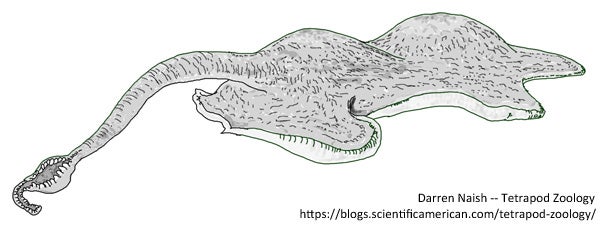
The Loch Ness Monster is surely a gigantic detritivorous lophotrochozoan akin to echiurans. Look, here's the proof. This was produced for a TV show but never used. Credit: Darren Naish
Crab-eating Madagascan skinks, chameleons and mole rats were covered on the blog, ep 51 of the podcats appeared (on Star Wars of all things), I produced text on fish fish fish fish fish and fish for my (STILL NOT COMPLETE) giant textbook on the vertebrate fossil record, and I went to Peterborough and worked on…. fossil fish. During March I participated in another beach clean event. I finished one part of the Eotyrannus monograph but found it unable to finish another part due to other work. That’s all I want to say on Eotyrannus for now – I cannot get it done until some other huge, time-sapping projects are out of the way. Do you know how frustrating it is when there are things that you Just. Cannot. Find. Time. To. Finish?
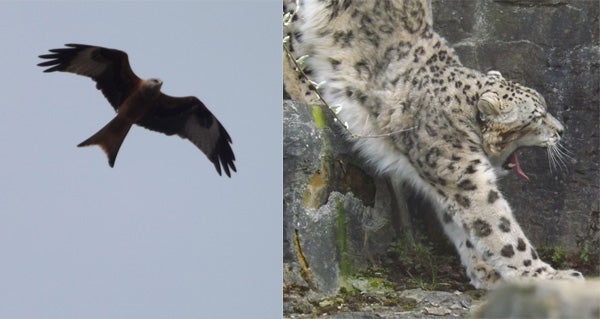
Animals encountered in April 2016. At left: Red kite Milvus milvus, a bird now easily seen in Hampshire (the part of southern England where I live). Right: yawning, stretching Snow leopard Panthera uncia at Marwell Wildlife. My daughter Emma adopted a Snow leopard in 2016. Credit: Darren Naish
Moving on, April was the month of Permian bears, Junin grebe conservation and World Tapir Day. Remember the magpie pair I wrote about back in June 2013? On 6th April, a Carrion crow located the pair's current nest and destroyed it: see the photos below. I went to Loch Ness for a TV project. Oh no, not Loch Ness again. I spent copious time at the loch itself (didn’t see any monsters; watched Mute swans and Common gulls a lot though) and also caught up with the inimitable Adrian Shine. Dick Raynor and I sat around, drinking, while looking at essentially all claimed ‘Loch Ness Monster’ photos, our general conclusion being that all are hoaxes, upside-down boats, waves or swans. The resulting TV show – part of the series World’s Greatest Hoaxes – was broadcast in October 2016. I was to be back at Loch Ness in the summer…
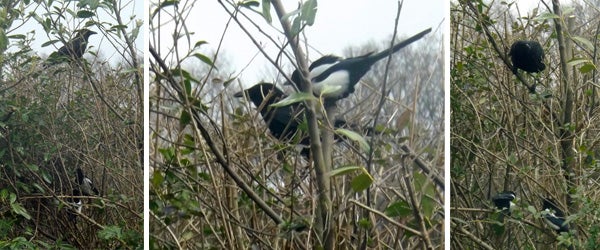
Crows do not like magpies, magpies do not like crows. These photos don't show all the details, but the crow located and destroyed the magpie's nest. Credit: Darren Naish
In early May I went to the Broadlands Country Show and did the usual gawping at chickens. I have it bad for chickens – this is becoming more and more obvious – and I hope that, one day, they will be rightfully recognised and get to take over the world.
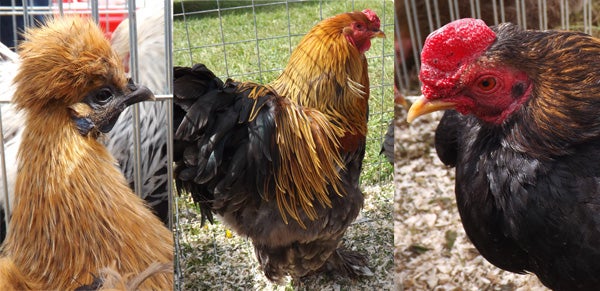
Chickens at the Broadlands Country Show, May 2016. Credit: Darren Naish
The guinea-pigs. Also in May, I was pleased to attend the University of Southampton Academic Awards Ball where I received awards but didn’t get to give my fully rehearsed speech. I also indulged in yet more grotesque Hunting Monsters promotion, talking about the book (specifically, about the evolution of ideas pertaining to sea monsters) to the Bournemouth Sceptics In The Pub group. I finished (well, ‘finished’) the gargantuan, accursed actinopterygian chapter of the textbook. I went to see guinea-pigs and saw a lot of guinea-pigs. Yeah, it was a guinea-pig-themed year alright, was 2016. A series of articles on Mesozoic maniraptoran dinosaurs appeared on Tet Zoo.

Willow, outside the polling station where I voted REMAIN. But Brexit happened anyway. Well done, citizens, well done. Credit: Darren Naish
In June, sirens, cassowaries, swimming giraffes (them again) and bigfoot were covered on the blog. My advanced copy of the Natural History Museum book Dinosaurs: How They Lived and Evolved, co-authored with Paul Barrett, arrived (Naish & Barrett 2016); so great to see it in print at last. Tickets for TetZooCon 2016 went on sale. Brexit happened. With actinopterygians (that’s ray-finned fishes) out of the way, I made efforts to finish the chondrichthyans chapter for The Big Book. Spoiler: I did finish it later in the year, and thus actually FINISHED ALL THE FISHES. During July, stegosaurs, mice from the Philippines, and squeakers (the frogs) were covered on Tet Zoo.
The Skeptics GeoTour. But the big deal about July was my disembarking for Don Prothero’s three-week-long Skeptics Society GeoTour of the UK, co-led by Don and myself. And, wow, what an event. I had an incredible time, met and hung out with many incredible people, and saw a huge number of incredible things. We travelled the length and breadth of the country, stayed in amazing places (castles, country homes, great hotels) and just had a brilliant time. I naturally turned my half of the tour (we had two coach-loads of people) into a sort of natural history/evolutionary zoology tour. There weren’t too many complaints.
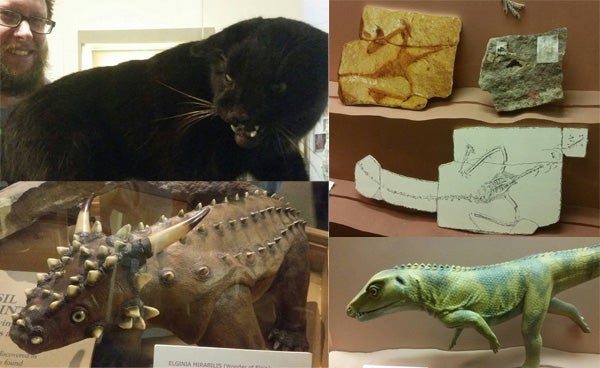
Tetrapods Triassic and modern encountered at the Elgin Museum, Scotland. The cat is an especially famous one you might recognise. The Triassic animals are Scleromochlus (upper right), and life-sized models of Ornithosuchus and Elginia (lower left). Credit: Darren Naish
As goes what we saw and where we went, I hardly know where to start. No, actually, I do: London. From there we visited Darwin’s House, the Crystal Palace dinosaurs at Sydenham, the White Cliffs of Dover, Cambridge, the Sedgwick Museum, the Oxford University Museum of Natural History, Lyme Regis, Stonehenge, Plymouth, Land’s End and other places in Cornwall, Bath, Cardiff, Swansea, South Wales, Shropshire, the Brecon Beacons, Darwin’s birthplace at Shrewsbury, Anglesea, Brimham Rocks, Lumley Castle, Hadrian’s Wall, Hutton’s unconformity, Edinburgh, Bannockburn, the Falkirk Wheel, the Scottish highlands, Loch Ness, Glasgow and more…
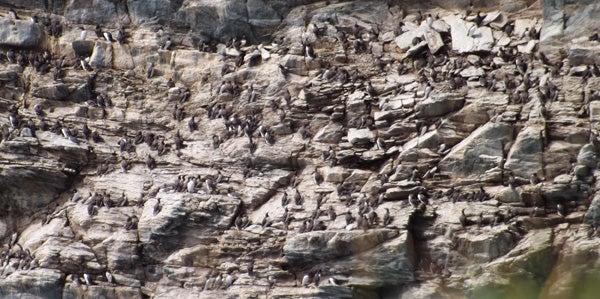
Guillemot colony observed at South Stack, Anglesea, in July 2016. Credit: Darren Naish
Anyway, such was my experience as a tour-guide that it looks like it’s a thing I’ll now be doing on at least a few other occasions. Indeed, I’m hopefully leading a special Tet Zoo (read: natural history- and zoology-themed) tour during the summer of 2017. For more information on this and the places involved on the tour, please go here.
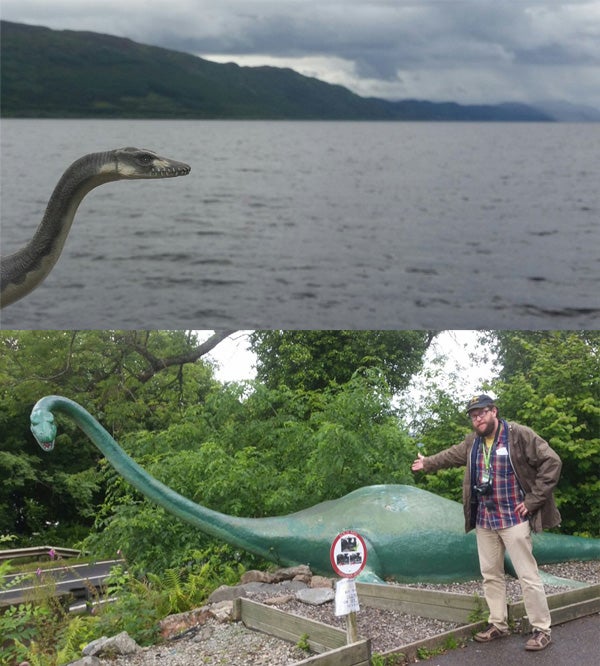
A July visit to Loch Ness... The sign in the bottom image says "please do not ride the monster" and has little photos of people sitting on the model's back. Credit: Darren Naish
I started a new Tet Zoo Reviews Zoos series and wrote about Edinburgh Zoo. Tet Zoo articles of the time also covered the dinosaurs (and other prehistoric animals) of Crystal Palace and herons. Dinosaurs: How They Lived and Evolved was now in the hands of many friends, associates and denizens of the TetZooniverse. And the cover proved something of a problem, hence the creation of #GiveDarrenABetterCover.
I work as a consultant for several companies that produce children’s books and try quite hard to get the dinosaurs and other fossil animals featured in these works to look at least semi-accurate in terms of our current understanding. Some of these books are great fun and I get to field-test them on my own kids (Emma is 7, so the ideal age for many of them). Works that appeared in 2016 include Usborne’s Build Your Own Dinosaurs Sticker Book (look for the Wittonesque pachyrhinosaur), Usborne’s Mosaic Sticker Dinosaurs, Usborne’s My Very First Dinosaur Book (look for the mistake on the cover) and Dorling Kindersley's Findout! Dinosaurs.
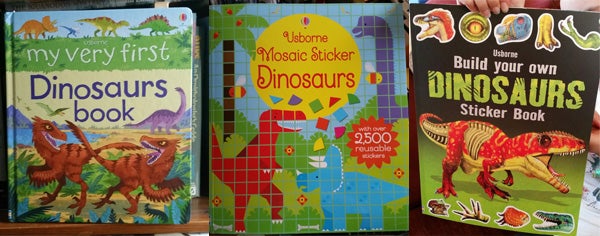
New kid's books on dinosaurs for 2016. Credit: Darren Naish
September at Tet Zoo also saw the publication of a very brief, placeholder article on stem-mammals, a group of animals that have still never received anything approaching adequate coverage here. This article was lifted – wholesale, pictures and everything – by David Peters for his own blog so that he could insert his own comments regarding his own interpretations of these animals into the text. This was seemingly motivated – not by the fact that I (along with everyone I’ve ever spoken to) criticise what Peters does and says on his blog – but by the fact that he doesn’t understand what the term ‘stem’ means. Look, no matter what disagreement you may have with someone, it is unethical (and rude, and dumb) to lift someone else’s article and republish it on your own blog. I tried to get Scientific American to take the article down, but nothing happened. Slow clap, Dave.
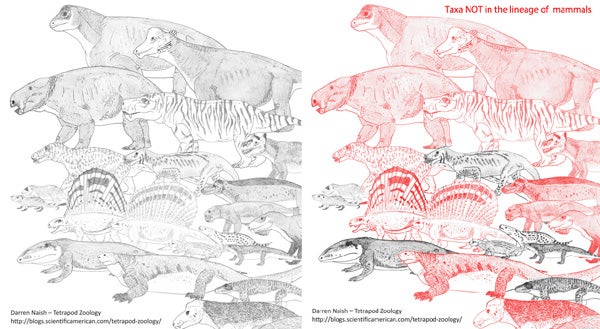
My stem-mammal montage, with the version vandalised by Peters on the right (the ones in red are those he was saying are not on the mammal lineage. Err, what?). Credit: Darren Naish
PopPalaeo, New Scientist Live, TetZooCon. September is the start of events season here at Tet Zoo Towers. Things started when I spoke at the Popularising Palaeontology conference (aka PopPalaeo) at University College London. PopPalaeo was organised by Chris Manias and featured a stellar line-up of people involved in the study of palaeontological outreach and popularisation… that’s right, I said the study of palaeontological outreach and popularisation, not palaeontological outreach and popularisation per se (so, stop complaining those of you who weren’t invited). I was part of the palaeoart contingent and spoke about palaeoart memes. Write-ups of several of the talks are already online; a write-up of mine will appear here at Tet Zoo very soon.
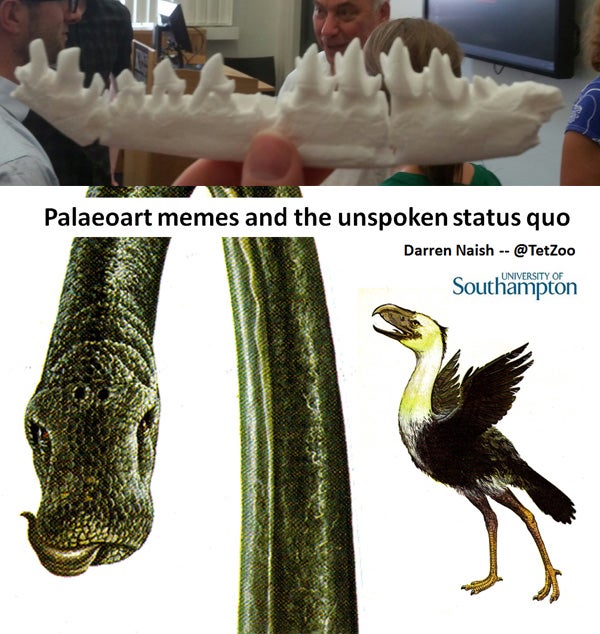
Scenes from PopPalaeo: much-enlarged, 3D-printed jaw of Mesozoic mammaliaform Palaeoxonodon ooliticus, brought along by Elsa Panciroli (specimen provided courtesy of describers Roger Close et al. and National Museum of Scotland), with conference-goers in the background, and the opening slide from my talk (which is online here). Credit: Darren Naish
New Scientist Live was the next event: I spoke about changing views on dinosaur life appearance, this talk intended to be an All Yesterdays spinoff (Conway et al. 2014) and including speculations on facial tissues, inflatable display structures, super-enlarged keratinised structures, fuzz, feathers, spines and elaborate scalation – the sort of stuff that many of us interested in dinosaur life appearance talk about on a regular basis (that’s right, it isn’t all feathers feathers feathers, you know). I did a book-signing (the first of several during the year) for Dinosaurs: How They Lived and Evolved; John Conway and I also signed and sold copies of All Yesterdays. Oh, thanks to Mike Wall I managed to mostly complete my set of Handbook of the Birds of Europe, the Middle East and North Africa: The Birds of the Western Palearctic. Yay!
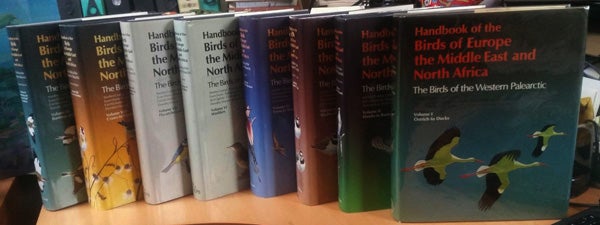
The Birds of the Western Palearctic, or BWP as it’s generally known. Credit: Darren Naish
And just a few days later… aaaand with some heavy meetings in between… and it was time for the Tet Zoo-themed event of the year, by which I mean TetZooCon, the 2016 meeting being the third TetZooCon so far, and by far the biggest. You can read about the event here. At the time of writing, plans are in full swing as goes getting things up and running for TetZooCon 2017. We’ve outgrown our previous venue (the London Wetland Centre) and need a new one, so I think I can announce that 2017’s meeting will be held at The Venue (part of Conferences Central & Student Central) at Malet Street in central London on Saturday October 21st. Watch #TetZooCon on twitter and the TetZooCon facebook page. Speaker slots are about filled already! Tickets are not yet on sale but will be available at our TetZooCon site.
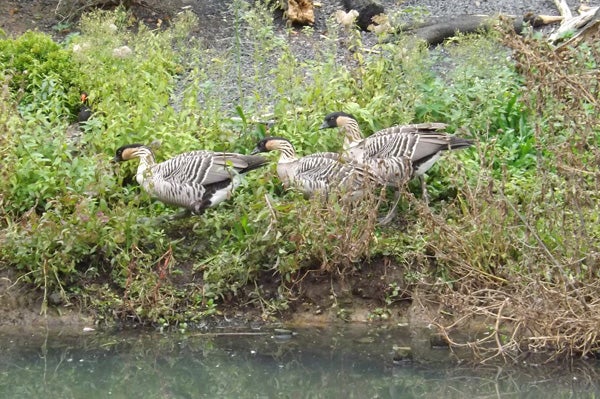
A group of captive Hawaiian geese Branta sandvicensis at the London Wetland Centre. I've deliberately cropped the photo this way as I like the visual interaction between the birds and the environment. Look for the cryptic rallid! Credit: Darren Naish
Having mentioned the London Wetland Centre, I attended and spoke at a dinosaur-themed event there at the end of October. Alas, the thing we mostly remember about this event was the BAND (= Birds Are Not Dinosaurs) talk in which the speaker explained to us how Deinonychus could not evolve into Archaeopteryx, how Ostrom’s ideas about pack-hunting should be viewed with scepticism, and how those silly feathered dinosaurs were but surely flightless archaeopterygiforms and safety unrelated to them big ol’ scaly dinosaurs. I was sure I’d fallen into a deep sleep where I dreamt about living in 1979 but the fashion and new-fangled electronics told me otherwise; at least I goaded Mike Benton into heckling.
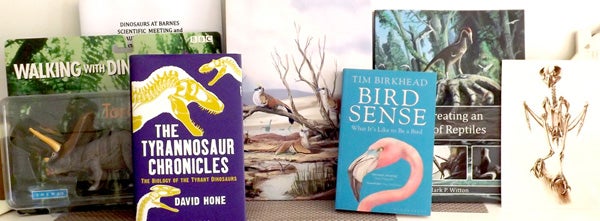
Things acquired at the Dinosaur Days event of late October. We see art by Katrina van Grouw and Mark Witton, books, toys... Credit; Darren Naish
Inflatothingies, Loch Ness again.World Cassowary Day, the Ozenkadnook tiger photo (another excuse to plug Hunting Monsters), thoughts on passerine phylogeny and dicamptodontid salamanders all appeared on Tet Zoo at about this time (September/October). I began delivery of my lecture course on vertebrate history at the University of Southampton, starting with… fish before swiftly moving on to amphibians, amniote diversification and Mesozoic archosaurs.
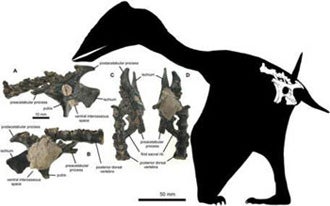
Vectidraco daisymorrisae, based on a partial pelvis and associated vertebrae, was published by myself and colleagues in 2013 (Naish et al. 2013). It's the focus of at least two in-prep or in-press follow-up studies. Credit: Darren Naish
I wrote a whole book on Cretaceous wildlife (we’ll come back to that later…) and made headway on another one with Don Lessem. I wasn’t able to attend any of the big palaeontology meetings in 2016, but ongoing work that Liz Martin-Silverstone and I are doing on pterosaurs was presented at the Society of Vertebrate Paleontology meeting in Utah (Martin-Silverstone & Naish 2016). This mostly revolves around Vectidraco, the British azhdarchoid that I and colleagues described in 2013 after it was found by young fossil-finder Daisy Morris.
I published – oh no – more on cryptozoology; this time, the bold and innovative article ‘How do we know that the Loch Ness Monster doesn’t exist?’ (Naish 2016b). The idea that the oft-mentioned scene in King Kong might have been influential as goes the Spicer sighting – a hypothesis promoted in my article – was contested in some arising correspondence, and contested by none other than fisheries biologist and statistician (and sea and lake monster expert) Charles Paxton. I’m not wedded to the hypothesis and am happy to go with Charles on this one.
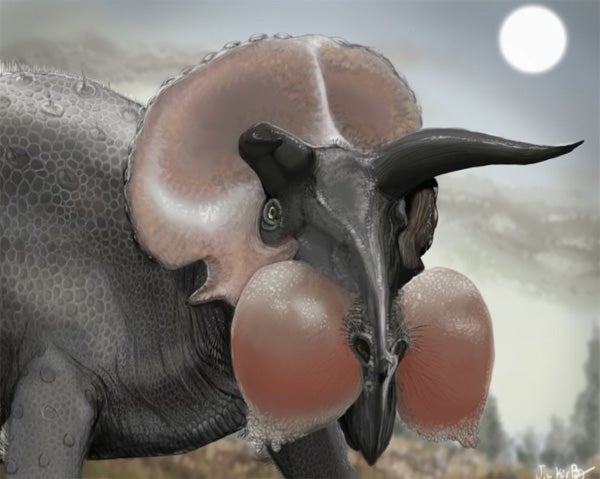
Triceratops reconstructed with speculative nasal inflatothingies in excellent artwork by J. W. Kirby, from here. Credit: J. W. Kirby
During late November I explained why ceratopsians might have had weird, inflatable nasal structures (aka inflatothingies). The speculative hypothesis promoted in this article caught the interest of many skilled artists, and some unskilled ones too, and consequently the internet became briefly awash with images of ridiculous, balloon-faced dinosaurs. Which is cool. A part-work on dinosaurs got underway (part-work: a publication that appears in stages over some period of time... like, a series of magazines). While in London in December with Will (my son) I met up with the excellent Paul Willis of Australia’s Science Channel. Paul is one of the first people I ever got to know online and he taught me everything I know about mekosuchines. Will and I also hung out with Dino Babs, who you know well for artwork like the image shown below and on the right (check out her Redbubble store)… (modesty prevents me from discussing some of the other stuff she works on)..
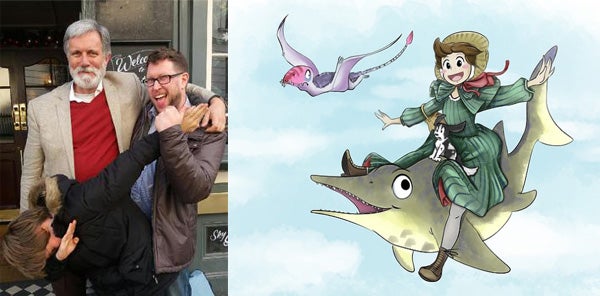
At left: Paul Willis and Darren Naish outside the Hoop & Toy (Paul's son in attendance too); Credit: Will Naish. At right: Mary's Grand Adventure, as depicted by Dino Babs (available here on merchandise). Credits: Darren Naish, Dino Babs
A series of articles on ‘non-standard hypotheses’ pertaining to the evolution of modern amphibians got started on Tet Zoo and the cover of the print edition of Hunting Monsters was released online.

Tet Zoo Towers, now with a Chi-Africa [there is a link there] Blackbird Turdus merula. Credit: Darren Naish
Finally, we come to January. The month has, so far, been work work work, but a long-in-development paper on azhdarchid pterosaurs finally appeared (Naish & Witton 2017). Obviously, I haven’t had time to discuss it here yet but will so do in time (my co-author Mark Witton has written about the study here). Here it’s worth saying that 2016 looks like a year in which I did no technical research, no paper writing. But I want you to note that this is completely misleading. 2016 was actually a year in which I did tons of academic writing and research, only for the projects concerned to wither and die due to the actions of others, or become delayed by months upon months due to the review process. A review paper on Jurassic ichthyosaurs was delayed due to the actions of editors and other authors submitting to the same volume, and technical papers on facial morphology in theropods, plesiosaur swimming behaviour and a Cretaceous nesting colony were completed and submitted but have yet to see daylight. Needless to say, 2016 did not see completion of my giant textbook…
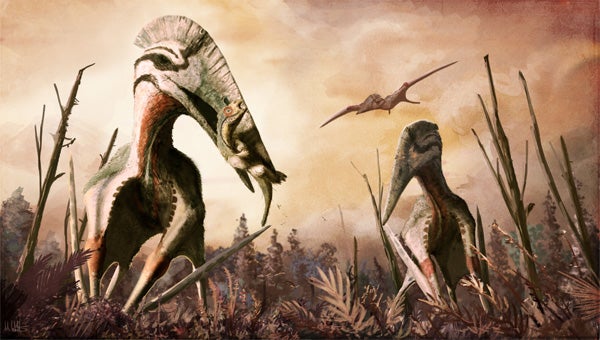
Hatzegopteryx reconstructed anew as a robust, relatively thick-necked predator, a view justified and explained by Naish & Witton (2017). Credit: Mark Witton, from Naish & Witton 2017
Once again, a failed effort to find balance. Anyway, that’s enough of that. To the moment of truth. How did Tet Zoo’s phylogenetic coverage stack up across 2016? Well, here are all the articles published during the year, arranged by category and with ‘miscellaneous’ articles listed first...
The Dinosaurs of Crystal Palace: Among the Most Accurate Renditions of Prehistoric Life Ever Made
Tet Zoo Bookshelf September 2016: of Fossil Primates and Nightjars
Tet Zoo Bookshelf November 2016: of Flying Dinosaurs, Extraordinary Birds and Camera Traps
Cryptozoology
Stem-Tetrapods
Amphibians
Squamates
By the Horns of Trioceros, the Casque of Calumma, the Brood of Bradypodion--Chameleons, Part 2
Palleon, Archaius, Kinyongia, Nadzikambia--The Last Chameleons, Part 3
Dinosaurs
Stem-Mammals
Mammals
And here’s the graph…
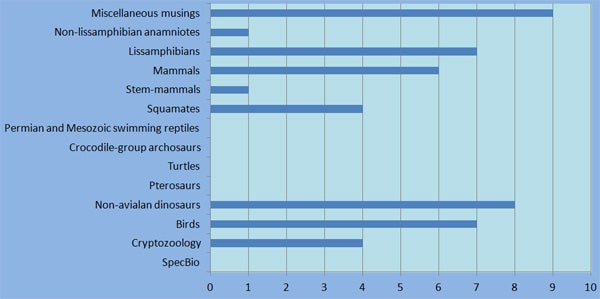
Regular readers will know that I strive for some sort of ‘fair balance’, whereby turtles, say, get written about just as much as mammals or dinosaurs do. I don’t know how I expect this to happen, I just kinda hope it does. Of course, it never does. And look how many groups received no coverage AT ALL. Fume. Dinosaurs (the bars here have birds and non-birds separate) are massively over-represented, beating all other groups hands-down – surprising, because I stupidly have it in my mind that I don’t cover dinosaurs much. Among other charismatic megafauna, mammals did ok in 2016, but note that at least some of this coverage concerned rodents. However, note that lissamphibians look reasonably well covered, and even overtook mammals. That’s good.
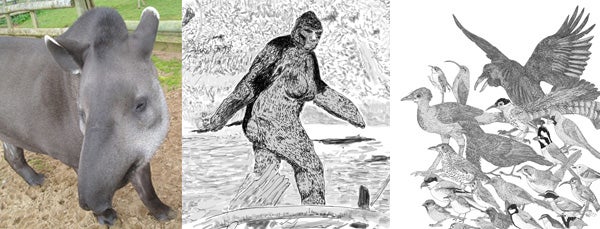
Tapirs, bigfoot, passerines - all things that saw coverage on Tet Zoo during 2016. Credit: Darren Naish.
As incredible and ridiculous as it might seem after 11 years of blogging, I still feel as if enormous swathes of the tetrapod tree have either not been covered at all at Tet Zoo, or have only been touched on superficially: there is still a huge amount I want to see covered. Plus, the march of progress requires that many things I’ve published now require update, revision or replacement. I’m always planning to cover those neglected groups (temnospondyls, fossil crocodylomorphs, obscure fossil mammal, extinct turtles), the great problem is that making the time to gather and generate the material is difficult and hard to fit in between other work… and I would do so much more if only I could (hint hint).
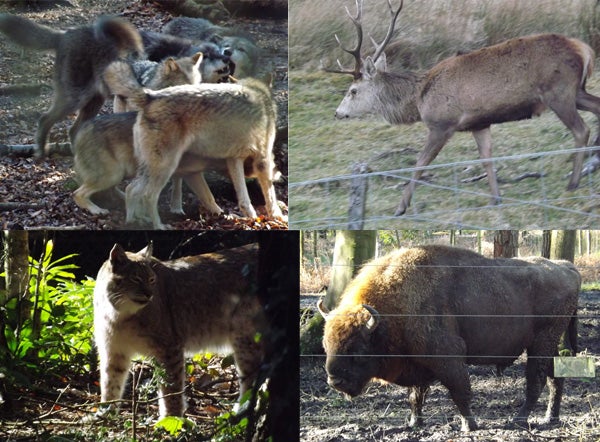
European mammals encountered in the wild and the not-so-wild (New Forest Wildlife Centre) in 2016. Clockwise from top left: Canis lupus, Cervus elaphus, Bison bonasus, Lynx lynx. Credit: Darren Naish.
This feels like a good place to finish. I want to thank all my readers, colleagues, friends and commenters for their support, advice and assistance across 2016 and beyond. 2017 will see the completion of some major projects that will be discussed here, and some not-so-major ones as well. It will also almost certainly see the biggest TetZooCon so far, and if you’re a long-time reader and have considered coming along, maybe this year is the time to do that. Farewell, and here’s hoping that 2017 is good to us all.
For previous Tet Zoo birthday articles, see...
It is with some dismay that I announce Tet Zoo's first hemi-decade
Tetrapod Zoology 10th-Birthday Extravaganza, Part 1: 2015 in Review
Tetrapod Zoology 10th Birthday Extravaganza, Part II: the Rest of 2015 Reviewed
Tetrapod Zoology 10th-Birthday Extravaganza, Part 3: Tet Zoo's Tetrapod Treatment in 2015
Refs - -
Martin-Silverstone, E. & Naish, D. 2016. Postcranial paleoneurology of pterosaurs. Journal of Vertebrate Paleontology 36 Supp 3, 184.
Naish, D. 2016a. Hunting Monsters: Cryptozoology and the Reality Behind the Myths. Arcturus, London.
Naish, D. 2016b. How do we know… that the Loch Ness Monster doesn’t exist? BBC Focus Sept 2016, 67-71.
Naish, D., Simpson, M. I. & Dyke, G. J. 2013. A new small-bodied azhdarchoid pterosaur from the Lower Cretaceous of England and its implications for pterosaur anatomy, diversity and phylogeny. PLoS ONE 8(3): e58451.